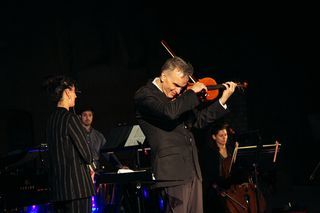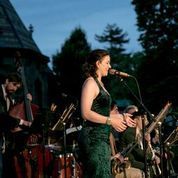|
Back
Beyond the Crypt New York
Greenwood Cemetery Entrance Gate
06/25/2021 -
William Bolcom: Lenny in Spats
Ludwig van Beethoven: Violin Concerto in D Major, Opus 61 (pocket edition by The Knights)
Gil Shaham (Violin), Members of The Knights: Alex Sopp (Flute), Colin Jacobsen (Violin), Caitlin Sullivan (Cello), Stephen Gosling (Piano), Ian Sullivan (Timpani); The Grand Street Stompers: Gordon Au (Leader, trumpet), Kim Hawkey (Vocals), Ricky Alexander (Tenor sax), Jake Handelman (Trombone), Vinny Raniolo (Guitar), Rob Adkins (Bass), Kevin Dorn (Drums)

G. Shaham (© Kevin Condon)
“I love a tree more than I love a human.”
Ludwig van Beethoven
If that was Beethoven’s attitude, then producer Andrew Ousley provided the endless trees last night. As well as the stars, the fireflies, the grassy knolls, and the Gothically elaborate Greenwood Cemetery Late Gothic gate as a background. Ms. Ousley has been using the cemetery for several years now with the most diverse settings.The Crypt, the perambulating grounds, and this huge gate, with the audience sitting on seats, sitting on the hillcocks, and presumably stretched out over the gravestones.
It took no time at all to accustom oneself to the Grand Street Stompers, who preceded Gil Shaham and The Knights. Promoted Dixieland jazz group, they were closer to a 1930’s combo, more Goodman/Hamton than Armstrong. The rhythms were there,. The counterpoint was clear, leader Gordon Au played a very mean trumpet indeed. Yet is was singer Kim Hawkey who stood above the others. This was a swinging lyrical voice which rarely improvised but kept giving vibes like Anita O’Day. As smooth, as mellifluous as any big-band singer of the era.

K. Hawkey (© Kevin Condon)
What was the following act? That was as “pocket edition” of Beethoven. The Violin Concerto was written for full orchestra–including the four timpani opening notes–taps which launched a thousand early 19th Century quips. That it is one of the most thrilling pieces in the repertory is obvious. But that is a piece of Classical orchestration–strings, pairs of oboes, clarinets, bassoons, horns, trumpets and timpani. And that was a major challenge here.
True, the Knights, a fungible virtuoso orchestra suitable for any occasion, is as impeccable as their soloist last night. And while the Violin Concerto was probably transposed to many a home chamber group in the pre-phonograph 19the Century, took a while last night to accustom oneself to the new abbreviated sounds.
The Knights’ arrangement as good as could be expected. We had the timpani (playing more than in the original), we had a piano which–with violin.,viola and cello–made up the string section. Yet, with all the expertise of flautist Alex Sopp, no solo flute can replace Beethoven’s subtle use of clarinets, oboes, bassoons and brass. The effort was endearing, the result still sounded undernourished, as if the group was hungry for more nourishment.
Not that this was all bad. To hear such a good amount of timpani, by Ian Sullivan satisfied the martial Napoleonic spirit of the composer. Most beautiful of all, soloist Gil Shaham’s violin and Colin Jacobson’s violin blended like this had been written as a concerto for two violins. Ravishing.
Then we Gil Shaham himself. I confess that each time he has played (the years were 10 B.C. to 2 B.C. (“Before Covid”) it has been an exalting experience. His breadth is not idiosyncratic or singular. Rather it is a breadth of the music itself. Played with an intensity, a passion and the confidence of the ultimate artist.
Yes, that first movement was not addictive, and one had to accustom oneself to the lack of colors. No excuses were needed for the Larghetto movement, with the emphasis on the “movement.” It was the Allegro rondo which started and ended with high spirits, with vibrancy, with two cadenzas (one apparently written by the soloist himself) and a delicious last few measures.
As for arrangement with The Knights, let’s just say that if Mr. Shaham was accompanied by a banjo, a jew’s harp, an accordion or a solo tam-tam, he would still play like Gil Shaham. And that, as they say at the end or a passover prayer, is sufficient.
Harry Rolnick
|